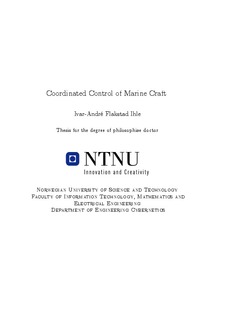| dc.contributor.advisor | Fossen, Thor | nb_NO |
| dc.contributor.author | Ihle, Ivar-Andre Flakstad | nb_NO |
| dc.date.accessioned | 2014-12-19T13:29:55Z | |
| dc.date.available | 2014-12-19T13:29:55Z | |
| dc.date.created | 2006-11-23 | nb_NO |
| dc.date.issued | 2006 | nb_NO |
| dc.identifier | 126263 | nb_NO |
| dc.identifier.isbn | 82-471-8096-0 | nb_NO |
| dc.identifier.uri | http://hdl.handle.net/11250/249846 | |
| dc.description.abstract | This thesis contains new results on the problem of coordinating a group of vehicles. The main motivation driving this work is the development of control laws that steer individual members of a formation, such that desired group behavior emerges. Special attention is paid to analysis of coordination issues, in particular formation control of marine craft where robustness to unknown environmental forces is important. Coordinated control applications for marine craft include: underway replenishment, maintaining a formation for increased safety during travel and instrument resolution, and cooperative transportation. A review of formation control structures is given, together with a discussion of special issues that arise in coordination of independent vehicles.
The main contributions of this thesis may be grouped into two categories:
• Path-following designs for controlling a group of vehicles
• Multi-body motivated formation modeling and control
A previously developed path following design is used to control a group of vehicles by synchronizing the individual path parameters. The path following design is advantageous since the path parameter, i.e., that parameter which determines position along a path, is scalar; hence coordination is achieved with a little amount of real-time communication. The path following design is also extended to the output-feedback case for systems where only parts of the state vector are known. The path following scheme is exploited further in a passivity-based design for coordination where the structural properties render an extended selection of functions for synchronization available. Performance and robustness properties in different operational conditions can be enhanced with a careful selection of these functions. Two designs are presented; a cascaded interconnection where a consensus system provides synchronized path parameters as input to the individual path following systems renders time-varying formations possible and increases robustness to communication problems; a feedback interconnection which is more robust to vehicle failures. Both designs are extended to sampled-data designs where plant and controller dynamics are updated in continuous-time and path parameters are exchanged over a communication network where transmission occurs at discrete intervals. Bias estimation is included to provide integral action against slowlyvarying environmental forces and model uncertainties.
A scheme for formation modeling and control, inspired by analytical mechanics of multi-body systems and Lagrangian multipliers, is proposed. In this approach to formation control, various formation behaviors are determined by imposing constraint functions on group members. Several examples illustrate these formation behaviors. The stabilization scheme presented is made more robust with respect to unknown time-varying disturbances. In addition, the scheme is extended towards adaptive estimation of unknown plant and parameters. Furthermore, it can be applied with no major modifications to the case of position control for a single vehicle.
The formation control scheme is such that it may be used in combination with a set of position control laws for a single vessel, thus enabling the designer to choose from a large class of control laws available in the literature. The input-to-state stability (ISS) framework is utilised to investigate robustness to environmental and communication disturbances. A loop-transform, together with the ISS framework, yields an upper bound on the inter-vessel time delay below which formation stability is maintained. | nb_NO |
| dc.language | eng | nb_NO |
| dc.publisher | Fakultet for informasjonsteknologi, matematikk og elektroteknikk | nb_NO |
| dc.relation.ispartofseries | Doctoral Theses at NTNU, 1503-8181; 2006:164 | nb_NO |
| dc.subject | Automatic control | en_GB |
| dc.subject | formation control | en_GB |
| dc.subject | cooperative control | en_GB |
| dc.subject | marine control systems | en_GB |
| dc.subject | robust | en_GB |
| dc.subject | passivity | en_GB |
| dc.subject | babckstepping | en_GB |
| dc.subject | iss | en_GB |
| dc.subject | TECHNOLOGY: Electrical engineering, electronics and photonics: Electrical engineering | en_GB |
| dc.title | Coordinated Control of Marine Craft | nb_NO |
| dc.type | Doctoral thesis | nb_NO |
| dc.source.pagenumber | 177 | nb_NO |
| dc.contributor.department | Norges teknisk-naturvitenskapelige universitet, Fakultet for informasjonsteknologi, matematikk og elektroteknikk | nb_NO |
| dc.description.degree | PhD i informasjons- og kommunikasjonsteknologi | nb_NO |
| dc.description.degree | PhD in Information and Communications Technology | en_GB |
